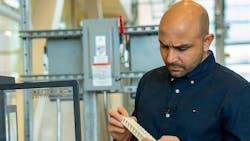Stable Structures Morph with Hypersonic Conditions
Electronic systems operated within hypersonic vehicles, such as missiles, must withstand rapidly changing operating environments, placing tremendous stress on many components. To better prepare electrical and mechanical components for these harsh operating environments, researchers at Purdue University are experimenting with morphing systems capable of adapting to changing environments. They are researching the materials and structures required for successful and reliable performance under stressful operating conditions within hypersonic missiles.
At Purdue (West Lafayette, IN), Andres Arrieta, associate professor of mechanical engineering, and Rodney Trice, professor of materials engineering, are designing aircraft systems with multistable structures (see figure). They are exploring combinations of materials and physical structures capable of adapting to changing operating conditions. They are also considering the requirements of different applications, such as the need for lighter-weight materials and structures for achieving longer flight times in aircraft and missile systems.
The structures they are seeking can morph in shape and in weight in response to external forces. These structures function through a combination of mechanical and material interventions that not only make morphing hypersonic systems possible but may also reduce weight and complexity. The technology is based on data from advanced sensors and structures programmed to respond to changes according to localized sensors. According to Arrieta, “Current mechanisms that help aircraft maneuver, like the aileron or tail, create noise and drag. These mechanisms are also chains of various parts, and each of these parts is joined by a joint. The more parts and joints you have, the more complex your system becomes.” As the solution, he explains: “So if we have a structure that is just one big part but is also capable of deforming, then there is potential to reduce not only complexity but also failure, maintenance costs and weight — which is the most important consideration in aviation.” The Purdue researchers are attempting to develop surfaces that can take on a variety of shapes for optimum performance over a range of aircraft speeds.
About the Author
Jack Browne
Technical Contributor
Jack Browne, Technical Contributor, has worked in technical publishing for over 30 years. He managed the content and production of three technical journals while at the American Institute of Physics, including Medical Physics and the Journal of Vacuum Science & Technology. He has been a Publisher and Editor for Penton Media, started the firm’s Wireless Symposium & Exhibition trade show in 1993, and currently serves as Technical Contributor for that company's Microwaves & RF magazine. Browne, who holds a BS in Mathematics from City College of New York and BA degrees in English and Philosophy from Fordham University, is a member of the IEEE.
